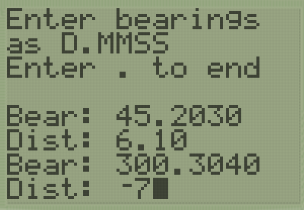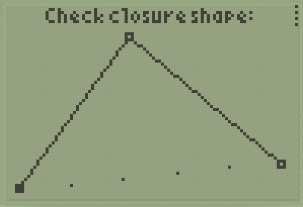CLOSURE2: Shape Closure Calculator
For Texas TI-84 Plus calculators. Calculates the bearing & distance of a shape’s missing side in degrees, minutes, and seconds. Also supports double-missing-distance.
Download coming soonCLOSURE free versionThis program operates on “whole circle” bearings (otherwise known as azimuths or “true bearings”), which go from 0° to 360°, using degrees, minutes and seconds. These bearings are commonly used throughout the British Commonwealth (UK, Australia, New Zealand, Canada, India, South Africa) as well as Russia, Brazil, Saudi Arabia and United Arab Emirates.
This program is useful in scenarios when:
- You want to find the direct bearing and distance between two points, but you only have indirect measurements (via other points)
- You want to convert a northing & easting (or a chainage & offset) into a bearing and distance
- You want to convert a bearing and distance into a northing & easting (or a chainage & offset)
- You want to find the “double missing distance”
Video Tutorial
Note: The ‘arbitrary datum’ aspect of the video has now been moved to a separate program and is no longer part of CLOSURE2.
Simple Example
Let’s say you have points A, B and C. You want to find the bearing and distance from A to C.
Run the
CLOSURE2program by pressing PRGM, scrolling toCLOSURE2and pressing ENTER twice.Choose option
1to “Start new” to start a new calculation.Enter the bearings and distances of the known sides. Bearings should be entered in the form
D.MMSS.If you have a bearing like
1° 1' 5"make sure you enter it as1.0105.Also make sure that you follow the sides of the shape in a consistent order (either clockwise or anti-clockwise). If you don’t, you’ll get an incorrect answer!

Since the first side was going in a clockwise direction and 300° is NOT in the same direction, we’ll need to reverse it by making the distance a negative:
-7.(You can also add 180° to the bearing, but making the distance negative is usually the simplest way.)
Enter a . with no other value to tell the program you’ve finished entering sides of the shape and to display the answer.
It will display the shape on the screen. This helps you check that it looks correct. If you entered a side going in the wrong direction, it should show up here.

Press ENTER to display the result. It should look like this:

This gives the bearing and distance, starting at the final point (C in our diagram) and returning to A.
The second bearing shows the reverse direction – rotated exactly 180°.
The distance is rounded to 3 decimal places as that is the most commonly used number, but in case you want more places, it is also shown in full below.
Re-Running Your Last Calculation
It’s often helpful to repeat the last calculation to check that all the values were entered correctly. To do this:
Once the program completes, press ENTER to run it again
Press 2 to
Redo lastThe bearings & distances you entered will be displayed on the screen, 3 sets at a time. Press ENTER to continue.
The result will be recalculated and displayed on the screen.
Making Small Changes To A Shape
If you entered several bearings & distances into the program and then realise that one was entered incorrectly, you can make changes without having to enter the whole set from scratch.
Finish running the program, or press 2nd, QUIT to exit the program.
Press STAT, ENTER to access the table editor. You should see
L1andL2in columns. These are the bearings and distances. Scroll to the cell you want to modify and press ENTER to open it for editing.Once your changes are complete, press PRGM and choose
CLOSURE2to re-run the program.Press 2 to
Redo last. This will re-run the calculation using the values from the table you just edited.
Working with Feet & Inches
If you want to perform a closure using feet & inches, and have it converted into metres, then you can enter the distance using the letters F and I. Here’s an example for 10ft 2in:

Press the ALPHA button to type letters into your calculator.
Double Missing Distance
Details to come soon. Checkout the video at the top of this page to see it in action.